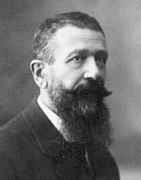Person: Burali-Forti, Cesare

Cesare Burali-Forti was an Italian mathematician best known for the Burali-Forti paradox of Cantorian set theory. He had about 200 publications.
The paradox resulted from the assumption that a set of all ordinals could exist.
Mathematical Profile (Excerpt):
- After schooling in Arezzo, Cesare attended the Military College in Florence, completing his secondary level studies there in 1879.
- Burali-Forti studied at Pisa from 1879 to 1884.
- For the first part of Burali-Forti's studies at Pisa, Volterra was a research student but he became Professor of Mechanics in 1883.
- Among the courses taken by Burali-Forti we mention those on infinitesimal analysis and higher analysis by Dini, and courses on rational mechanics, celestial mechanics and mathematical physics taught by Betti.
- Immediately after graduating Burali-Forti taught at the Technical Institute in Augusta, Sicily, where he was appointed on 29 August 1886, but he moved to Turin in 1887 when he was successful in the competition for an extraordinary professorship at the Military Academy of Artillery and Engineering.
- Burali-Forti spent the rest of his career at the Military Academy.
- Some of Burali-Forti's colleagues at the Military Academy were particularly important in his developing research interests.
- On 13 November 1887, just a few weeks after Burali-Forti was appointed, Giuseppe Peano joined the faculty of the Military Academy.
- Through the years Burali-Forti did much to bring Peano's work to a wider audience.
- Also Mario Pieri was hired as a professor in the Military Academy in the same year as Burali-Forti and remained there until 1 May 1900, when he moved to Sicily, having won the competition for a professorship in projective and descriptive geometry at the University of Catania.
- A university teaching position would have been more to Burali-Forti's liking but in this he had difficulties.
- However, at this time many mathematicians opposed vector methods and unfortunately these views prevailed on the committee that considered Burali-Forti's submission for a libera docenza, the necessary qualification to hold positions in a university and to enter competitions for a university chair.
- The fact that he was working at the Military Academy and not a university put Burali-Forti in a more difficult position regarding research than other academics.
- In 1893-94 Burali-Forti gave an informal series of lectures on mathematical logic at the University of Turin.
- After the course the lectures were written up as the book Logica matematica and Burali-Forti presented a copy of the book to the Academy of Sciences of Turin in June 1894.
- At the start of the 1894-95 academic session, Burali-Forti became Peano's assistant at the University of Turin.
- Burali-Forti attended the Congress and presented a paper Postulats pour la géométrie d'Euclide et de Lobatschewsky Ⓣ(Postulates for Euclidean geometry and Lobatschevsky's geometry) to the Geometry section of the Congress.
- Burali-Forti is famed as the first discoverer of a set theory paradox in 1897 which was framed in technical terms but in essence reduces to a 'set of all sets' paradox.
- Burali-Forti's paradox appeared in his paper Una questione sui numeri transfiniti Ⓣ(A question on transfinite numbers) (1897).
- One reason certainly seems to be that Burali-Forti had confused Cantor's well-ordered sets with what he called 'perfectly ordered sets'.
- Even after Bertrand Russell had discovered his own "set of all sets" paradox in 1903, he did not seem to realise that it had any connection to Burali-Forti's paradox.
- observed that he could not accept Burali-Forti's conclusion that ordinal numbers are not necessarily comparable, preferring to accept Cantor's results in this connection as established.
- He urged that Burali-Forti's contradiction could be simply resolved by denying the premise that the series of all ordinal numbers is well-ordered, "...
- Burali-Forti's language was new and strange, and intelligible to but few mathematicians.
- Peano also inserted in the fourth volume of the 'Formulario' (1902-03) some notions of projective geometry taken from Burali-Forti's three reports entitled 'Il metodo di Grassmann nella Geometria proiettiva' Ⓣ(The Grassmann method in projective geometry).
- Not only was Burali-Forti a prolific writer, with over 200 publications, he was also very interested in how to teach mathematics.
- Burali-Forti joined Mathesis in academic year 1897-98.
- We have mentioned that Burali-Forti was a close friend of Peano's but his closest friend and mathematical collaborator was Roberto Marcolongo.
- Burali-Forti and Marcolongo were called the "vectorial binomial" by their friends.
- Burali-Forti never understood the theory of relativity and, in 1924, Burali-Forti, in collaboration with Tommaso Boggio (1877-1963), published Éspaces Courbes Critique de la Relativité Ⓣ(Curved spaces: Critique of relativity).
- Burali-Forti died in Turin's Mauriziano Hospital suffering from stomach cancer.
Born 13 August 1861, Arezzo, Italy. Died 21 January 1931, Turin, Italy.
View full biography at MacTutor
Tags relevant for this person:
Analysis, Origin Italy, Set Theory
Thank you to the contributors under CC BY-SA 4.0! 

- Github:
-

- non-Github:
- @J-J-O'Connor
- @E-F-Robertson
References
Adapted from other CC BY-SA 4.0 Sources:
- O’Connor, John J; Robertson, Edmund F: MacTutor History of Mathematics Archive
